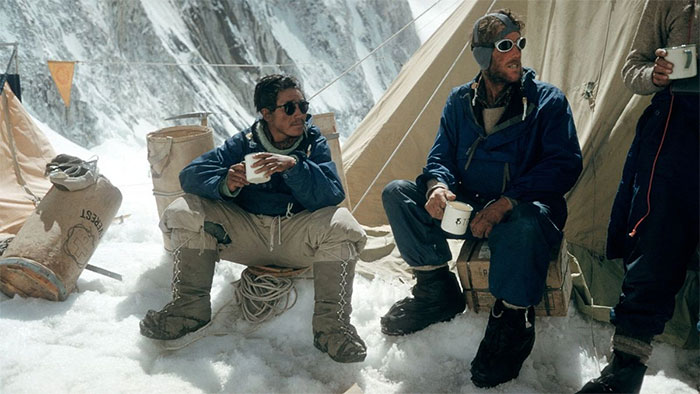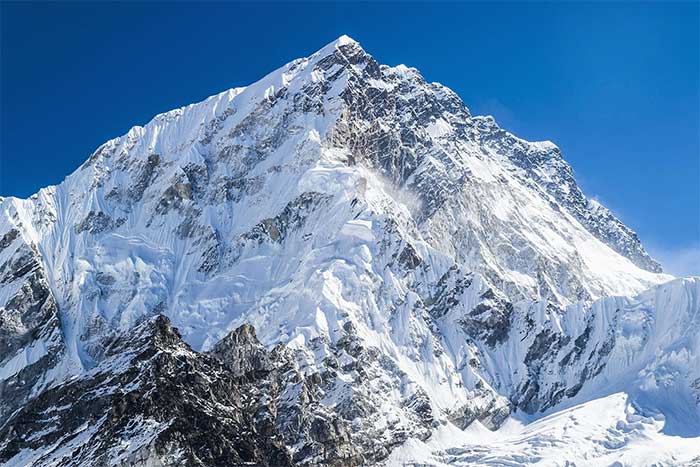Located in the Mahalangur Himal range of the Himalayas, along the border between Tibet and Nepal, Mount Everest stands at a height of 8,849 meters above sea level. This makes it the tallest mountain in the world.
Who were the first explorers of Everest?
Mount Everest has two main climbing routes: the Southeast Ridge from Nepal and the North Ridge from Tibet. Although the North Ridge route is shorter, most climbers today prefer the Southeast route due to its easier accessibility.

Tenzing Norgay and Edmund Hillary having tea in the Western Cwm – a glacial valley at the foot of Mount Everest on May 30, 1953. They were the first explorers to officially summit Everest on May 29, 1953 (Photo: Getty Images).
In 1921, during a British reconnaissance expedition, climber George Mallory mapped the North Ridge route to Everest. In 1922, he and fellow climbers Geofrey Bruce, Charles Granville Bruce, and Austrian chemist George Finch attempted to reach the summit for the first time using supplemental oxygen, but they were thwarted by an avalanche.
In June 1924, Mallory and British climber Andrew Irvine made another attempt but did not survive. In a later expedition in 1999, Mallory’s body was discovered. The melting ice in the area, due to climate change, has led to the discovery of more climbers’ remains in recent years.
From the 1920s and 1930s, there were early attempts to summit from Tibet, but this route was officially closed after Tibet’s incorporation into China in 1951. As a result, British explorer Bill Tilman, along with Americans Charles Houston, Oscar Houston, and Betsy Cowles, approached Everest via Nepal along a gradually developed route that has since become the primary access point from the south.
In 1952, members of a Swedish expedition led by Edouard Wyss-Dunant reached an altitude of 8,595 meters via the Southeast route, setting a new record. Tenzing Norgay, a member of the expedition and a Sherpa from Nepal, joined another British expedition the following year.
In 1953, a British expedition led by John Hunt returned to Nepal. He selected four climbers, forming two pairs to summit the mountain. The first pair, Tom Bourdillon and Charles Evans, turned back just 91 meters from the summit due to oxygen issues. Two days later, the second pair, New Zealander Edmund Hillary and Norgay, reached the summit. They took a few photos, left some candy, and a cross at the top.
Today, the mountain has become more accessible. A 2022 study indicated that the glaciers on Everest are melting rapidly due to climate change, leading to more frequent avalanches. The South Col glacier, the highest in the world, has thinned by 55 meters over the past 25 years. However, the warming temperatures and loss of ice have also made the ascent easier.
Technology has also made climbing safer. Nowadays, climbers can easily access supplemental oxygen during their ascent, and if they feel exhausted, they can be airlifted down by helicopter.
When was Everest first measured?

Siberian ibex (Capra ibex sibirica) inhabiting the arid rocky mountains of Gilgit-Baltistan, Karakoram, and Hindu Kush (Photo: Zahoor Salmi/Getty Images).
According to the Geological Sciences Department at the University of Montana, USA, Mount Everest was first identified in 1856. At that time, a comprehensive survey of British India named it Peak XV, with an elevation of 8,840 meters. However, the survey faced challenges as Nepal did not allow surveyors to enter.
The currently recognized height was established during a joint survey conducted by Nepal and China in November 2021, although technically, Everest’s height is changing. According to the United States Geological Survey, the mountain is gradually rising due to tectonic activity and rising sea levels.
In 1865, British General Andrew Waugh in India proposed naming the mountain after his predecessor, George Everest. For centuries, the Tibetans referred to the mountain as Chomolungma, meaning “Goddess Mother,” but Waugh was unaware of this because Nepal and Tibet were closed to outsiders.
Mount Everest has always attracted seasoned climbers and some amateur climbers from around the world. They often rely on Sherpas as guides, as Sherpas are a Tibetan ethnic minority known for their knowledge of the Himalayas and climbing skills. Climbing more than 3,350 meters from base camp to the summit in an environment with very thin oxygen is no easy feat. Altitude sickness, weather conditions, winds, and in rare cases, altitude-induced mental disorders are significant obstacles to conquering this mountain.
Veteran climber Alan Arnette stated: “It’s like holding your breath while climbing a staircase, and not just any staircase, but as if it were the staircase in the Empire State Building.”
More than 6,000 people have reached the summit of Everest, and over 300 individuals have died while attempting to climb it. Among those who succeeded, 80% have done so since the year 2000.
Milestones on Everest

The Nepal side of Everest viewed from Khumbu, Northeast Nepal. (Photo: John Harper).
1895: British General Andrew Waugh in India proposed naming the highest peak of the Himalayas after his predecessor, Sir George Everest.
1921: British explorer George Mallory mapped the climbing route on the North Ridge.
May 29, 1953: Tenzing Norgay and Edmund Hillary became the first explorers to officially summit Everest.
May 20, 1965: Native Nawang Gombu became the first person to summit the mountain twice.
May 16, 1975: Junko Tabei from Japan became the first woman to summit Everest.
May 3, 1980: Japanese climber Yasuo Kato became the first non-Sherpa to summit the mountain twice. He first reached the summit in 1973. He passed away in 1983 while attempting to climb for the third time.
August 20, 1980: Reinhold Messner from Italy became the first person to summit Everest solo.
1996 climbing season: 16 people died while climbing, the highest number of fatalities in a single year up to that point. On May 10 alone, 8 people died due to a storm on the mountain.
May 22, 2010: Native Apa summited Everest for the 20th time. He first reached the summit on May 10, 1990.
May 23, 2013: At age 80, Japanese climber Minura Yuichiro became the oldest person to summit Everest.


















































